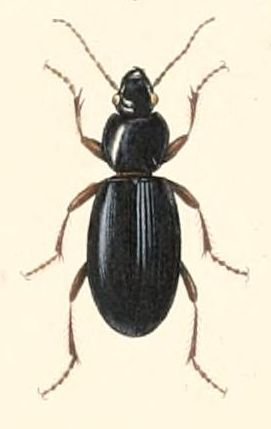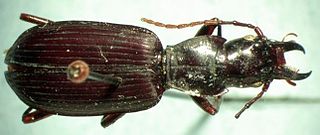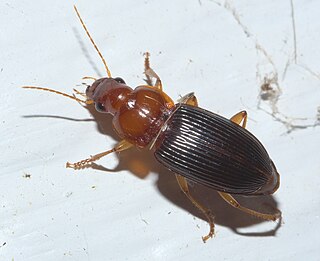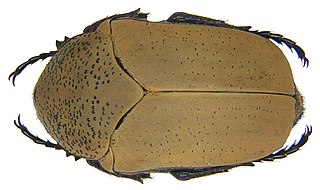
Harpalinae is a subfamily of ground beetles that contains more than 3,000 species in 4 tribes worldwide, according to the Carabcat Database. A rarely used common name for the subfamily is the harp beetles. The Harpalinae contain the most apomorphic ground beetles, displaying a wide range of forms and behaviors. Some are, rare among ground beetles, omnivores or even herbivores.

Entomobryidae, sometimes called "slender springtails", is a family of springtails characterised by having an enlarged fourth abdominal segment and a well-developed furcula. Species in this family may be heavily scaled and can be very colourful. The scale-less Entomobryidae are commonly caught in pitfall traps around the planet, and also occur in canopy faunas high up in trees. There are more than 1700 described species in Entomobryidae.

Monochamus is a genus of longhorn beetles found throughout the world. They are commonly known as sawyer beetles or sawyers, as their larvae bore into dead or dying trees, especially conifers such as pines. They are the type genus of the Monochamini, a tribe in the huge long-horned beetle subfamily Lamiinae, but typically included in the Lamiini today.

Scaphinotus is a genus of beetles in the family Carabidae. There are at least 60 species, all native to North America. They eat snails and are generally limited to the moist environments where snails live. These beetles are flightless.
Discoderus is a genus of beetles in the family Carabidae, containing the following species:

Notiobia is a genus of ground beetles in the family Carabidae. There are at least 90 described species in Notiobia.
Dercylus is a genus of beetles in the family Carabidae, containing the following species:
Dyscolus is a very large genus of beetles in the family Carabidae, containing the following species:
Elliptoleus is a genus of beetles in the family Carabidae, containing the following species:
Incagonum is a genus of ground beetles in the family Carabidae. There are more than 20 described species in Incagonum, found in South America.

Rhadine is a genus of beetles in the family Carabidae, containing the following species:

Blennidus is a genus of beetles in the family Carabidae, containing the following species:

Hybothecus is a genus of beetles in the family Carabidae, containing the following species:
Paratrechus is a genus of beetles in the family Carabidae, containing the following species:
Pelmatellus andium is a species of ground beetle in the genus Pelmatellus.
Pelmatellus balli is a species of ground beetle in the genus Pelmatellus.

Harpalini is a tribe of a diverse group of ground beetles belonging to the subfamily Harpalinae within the broader family Carabidae. The tribe contains more than 2500 species.

Hologymnetis is a genus of fruit and flower chafers in the family Scarabaeidae. There are about eight described species in the genus Hologymnetis.
Pelmatellus obtusa is a species of ground beetle in the family Carabidae.










